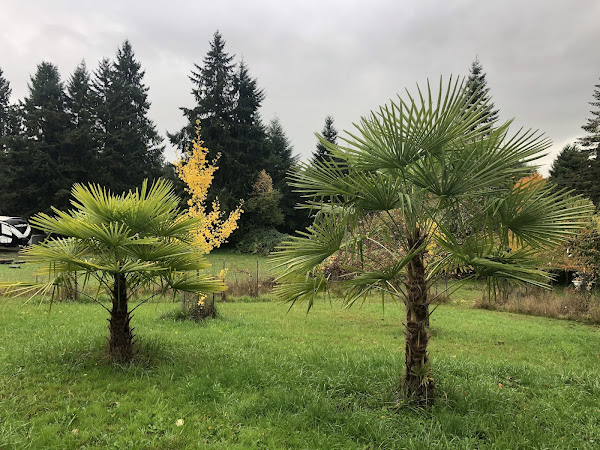This one is done until the soil comes. I'm leaving the end open so I can wheel in the soil with a wheelbarrow, then finish the end
and add the last amount of soil using a bucket.
I do want these done before Winter really sets in, so the soil can settle in and mellow with the compost that I will mix into it.
Tuesday, November 02, 2021
Work on A Newer, Taller, Bigger Raised Bed. 11.2.2021
I have two big raised beds to build. These are two feet tall, compared to the last ones that were 18 inches. The taller size is much easier for me to work with hand tools, keep cleaner, mulch, thin, harvest. This is all about easier, more accessible gardening so I can continue doing it for more years to come.
After pricing various wood and metal options, these cement blocks turned out to be the most economical option, by far. Plus, I think they will last for the rest of my life. I've used this kind of block in the past, and was happy with them.
For the base, I'm using two barriers. Some wire fencing, and plastic chicken wire. These are what I had around from old garden fences. I hope they keep moles from digging up into the beds. I'm also adding barrier to the pathways because moles tend to undermine blocks at the sides of raised beds. This will need some touching up, and if I'm lucky the moles will travel further so they don't damage my work so much.
These are longer than my previous garden beds, deeper, and wider. I tried making them even more wider, but could not easily reach the middle. The idea is to make it easier for me, so I narrowed the bed slightly. I can reach the center of this bed, barely. Good enough to use a small hand hoe, and do the various maintenance tasks.
The capstones are reused X 3 or X 4 times. In their last life, they were edging. Before that, Capstones. Before that, a large patio and walkway. They give a nice, aged, finished look and not as stark as the bare cement blocks, I think. Plus capping the cement blocks creates an air pocket to insulate the soil a bit, and keeps weeds out of the holes.
This construction project is a bit much for me now. I can carry and install about ten blocks in a day. Twenty if I push myself really hard. Then I regret it. The hardest part is getting them level, even, and plumb, which takes multiple tries on the soil base. There's no hurry - They are about 90 blocks, so if I average 15 a day, then it's only 6 days.
The First Schlumbergera Cactus of the Year. 11.2.2021
I repotted this one during Spring. It was a grocery store purchace a few years ago, just now starting to get some nice size.
Nikita's Gift Persimmons. 11.2.2021
These are my favorites. They are not quite ripe. They can be ripened indoors so that birdies don't eat them.
Tuesday, October 26, 2021
Persimmon Trees. 10.26.2021
Here are some of the persimmon trees.
First, Nikita's Gift, a Ukranian hybrid of American and Asian species, on D. lotus rootstock. Nikita's gift, so far, is my most productive and tasty persimmon. Nikita's gift persimmons ripen in Nov or Dec.
Saijo, an ancient Japanese variety. This is also on D. lotus rootstock. This tree isn't nearly as vigorous or productive as Nikita's Gift. It's still a nice persimmon. The tree always looks a little sick, but always makes a few fruits anyway. Ripening is similar to Nikita's Gift.
Yates, American persimmon. This tree usually produces OK, smaller and earlier fruits. this year either it didnt make any or they already fell off. I suspect the incredible heat spell during bloom time, as responsible.
Then there is Prairie Star. Very small persimmons, flavor quite nice.
I also have two very small trees, Coffee Cake (Nishimura wase) Persimmon and Chocolate Persimmon. They are in an out of the way location, and don't get any care. Despite dryness and weeds, they grew about a foot this year. I didn't water or weed at all. That encourages me to do more for the next year.
Gingko Trees. 10.26.21
These are the two ginkgo trees that I gre from deeds my dad collected in the mid 1990s. At the time, I was living in Chicago in an apartment. I grew them in flower pots on the porch. Here, I planted them in the Vancouver yard. I moved the smaller two to Battleground in 2012. One died after a year. The other grew, then the top died but it grew back from low on the trunk.
This is the one in Vancouver. It's male (so none of those stinky bombs that people hate). It's a tall, elegant, handsome tree.
This is the one that I moved to Battleground, that "came back from the dead". It has a similar shape as the Vancouver gingko, but far from as large. I feel optimistic it will continue to grow over the years.
The Windmill palms were also planted in about 2012 to 2014.
I doubt this one will grow to the magestic size of the Vancouver tree within my lifetime, but who knows?
There is also a smsll grove of ginkgo trees that we try to keep trimmed as big bonzai trees, plus one planted near thecwoodlot and another that has roots from a Vancouver seedling but the too is from the tall one grown from my Dad's seeds. That one always leans over. It doesn't want to grow straight. I don't know why.
Subscribe to:
Posts (Atom)











